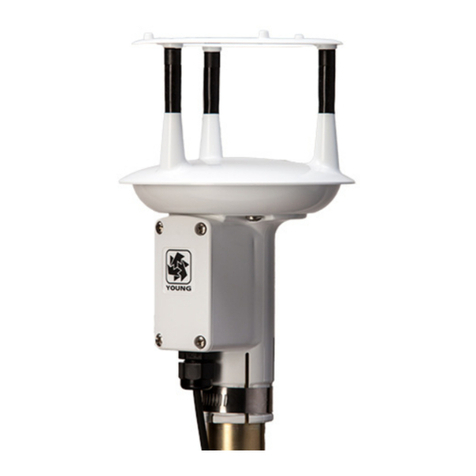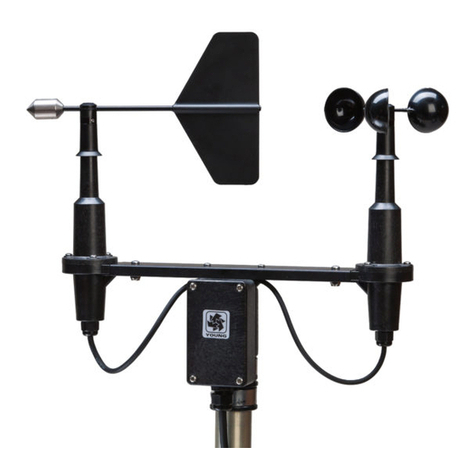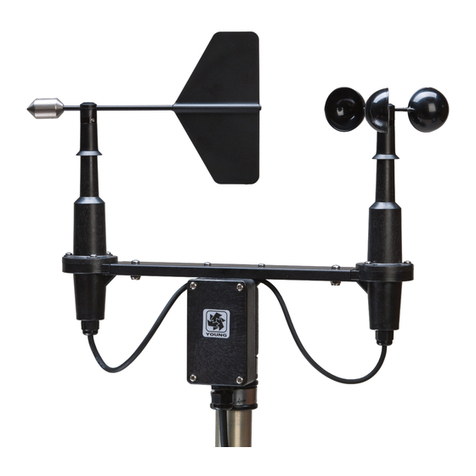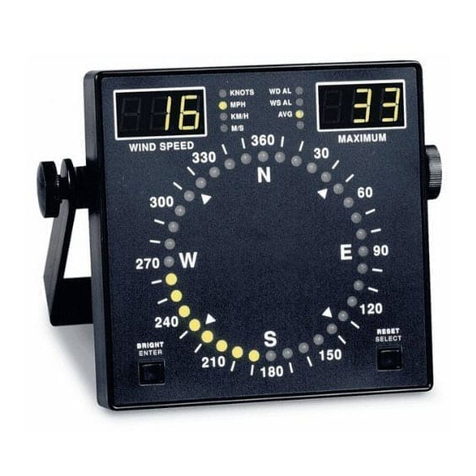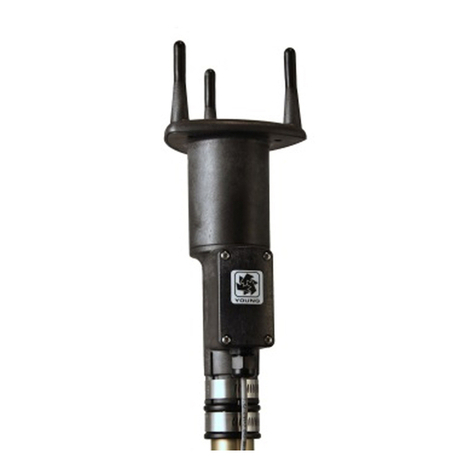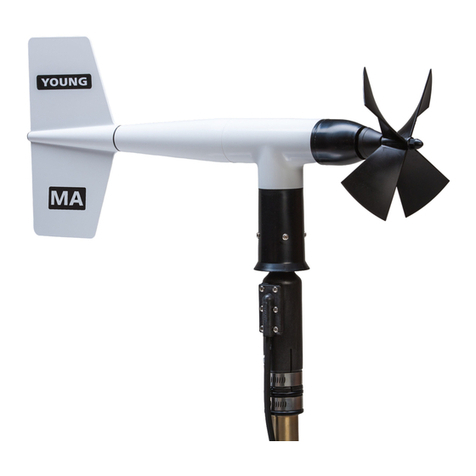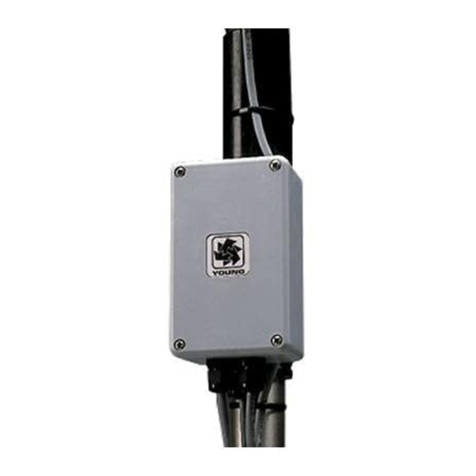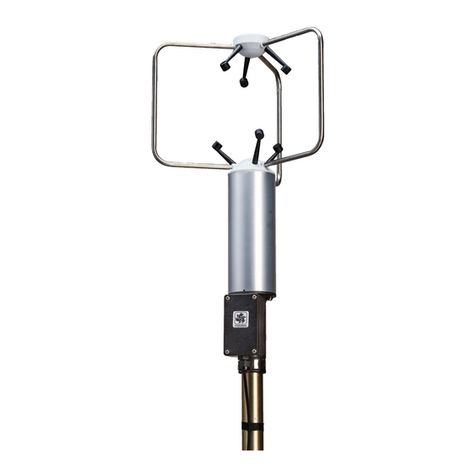
86000-SDI-90(G)
Page 2
4.0 OPERATION
4.1 SDI-12 MEASUREMENT COMMANDS
Model 86000-SDI uses the SDI-12 (v1.3) serial communication
protocol to initiate wind measurements and set sensor operation
parameters. The default sensor address is 0 (zero), and can be
changed to any valid single-character value if needed. Additional
details about the SDI-12 protocol may be found at www.sdi-12.org.
After initial power-up with 12 VDC, the sensor is in a low-power
standby state with a quiescent current of 2.3 mA.
A valid and properly addressed SDI-12 command wakes the sensor
to initiate a wind measurement, or set or check operating parameters.
After command processing has nished, the sensor returns to the
low-power standby state.
SDI-12 'M' or 'C' commands initiate a wind measurement. The sensor
response message indicates the maximum time needed before the
measurement is ready, and that two data values will be available.
The maximum time ranges from 1 to 5 seconds depending on the
Sample Count.
If an 'M' command initiates a measurement, the sensor sends
a Service Request when the wind measurement is ready to be
retrieved. When the polling device receives the Service Request
it then sends a 'D' command to request measurement results from
the sensor. With 'C' commands, no Service Request is sent, and the
polling device must wait the full delay time before sending the 'D'
command to request the measurement.
Measurement commands and responses are listed below.
SDI-12
COMMAND RESPONSE
aM! attt2<CR><LF>
aMC! attt2<CR><LF>
aC! attt02<CR><LF>
aCC! attt02<CR><LF>
aD0! a+www.ww+ddd.d<CRC><CR><LF>
a±uu.uu±vv.vv<CRC><CR><LF>
where:
a= Sensor address
ddd.d = Wind direction (degrees)
www.ww = Wind speed (selected units)
ttt = Delay time (seconds)
±uu.uu = U-axis wind speed (m/s)
±vv.vv = V-axis wind speed (m/s)
<CRC> = CRC checksum (only where requested)
<CR><LF> = Carriage return, line feed (ASCII 13, 10)
Wind data format depends on the sensor Output Format parameter
setting (polar or Cartesian).
4.2 SDI-12 NON-MEASUREMENT COMMANDS
The SDI-12 protocol includes standard commands for identifying the
sensor and changing its address.
SDI-12
COMMAND RESPONSE
?! a<CR><LF>
a! a<CR><LF>
aI! a13 YOUNG 86000 v1.00<CR><LF>
aAb! b<CR><LF>
a= Sensor address
b= New sensor address
4.3 EXTENDED COMMANDS
The SDI-12 command set may be customized with Extended
Commands to accommodate manufacturer settings and other
functions. Extended Commands for the 86000-SDI and the sensor
response are listed below. Where two responses are shown, one
is for a valid command, the other is for an invalid (ERR) command.
Note that only the aXP! command sends a response message.
EXTENDED
COMMAND DESCRIPTION & RESPONSE
aXB! Burn parameter settings to ash.
aXB,OK<CR><LF>
aXFn! n = Output Format code.
0 or 1 (Polar or Cartesian)
aXF,F=n<CR><LF>
aXF,ERR F=0/1<CR><LF>
aXHn! n = Heater Enable.
Not applicable in this model. Do not enable.
aXMnnnnn!
nnnnn = WS Multiplier x 10000 (00000 to 30000)
aXM,M=nnnnn<CR><LF>
aXM,ERR M=00000-30000 ONLY<CR><LF>
aXO±nnnn!
±nnnn = Dir Offset (-3600 to +3600 degrees)
aXO,O=±nnnn<CR><LF>
aXO,ERR O=-3600 - +3600 ONLY<CR><LF>
aXP! Parameter report
aXP,H=h,F=f,U=u,T=t,S=s,W=w,O=o,M=m,V=v<CR><LF>
a = Sensor address
h = Heater enable
0=Disabled, 1=Enabled, 2=Test
f = Wind format 0=Polar, 1= Cartesian
u = Polar wind speed units
1=mph
2=knots
3=km/h
4=m/s
t = Threshold, polar only (0-150 cm/s)
s = Sample count, internal (1-800)
w = Wait (seconds)
o = Wind Direction Offset (degrees)
m = Wind Speed Multiplier
v = Supply Voltage (VDC)
aXSnnn! nnn = Sample Count (001-800 samples)
aXS,S=nnn<CR><LF>
aXS,ERR S=001-800<CR><LF>
aXTnnn! nnn = Wind Speed Threshold
000 to 150 cm/s
aXT,T=nnn<CR><LF>
aXT,ERR T=000-150<CR><LF>
aXUn! n = Wind Speed Units code
1=mph
2=knots
3=kmph
4=m/s
aXU,U=n<CR><LF>
aXU,ERR U=1/2/3/4<CR><LF>
IMPORTANT! PARAMETER CHANGES MUST BE STORED
IN FLASH MEMORY USING THE aXB! COMMAND OR THEY
WILL REVERT TO PREVIOUSLY STORED VALUES AT
POWER UP. The aXB! command may be sent after all changes
have been made, or not sent at all if the changes are temporary.
(Continued on following page)
